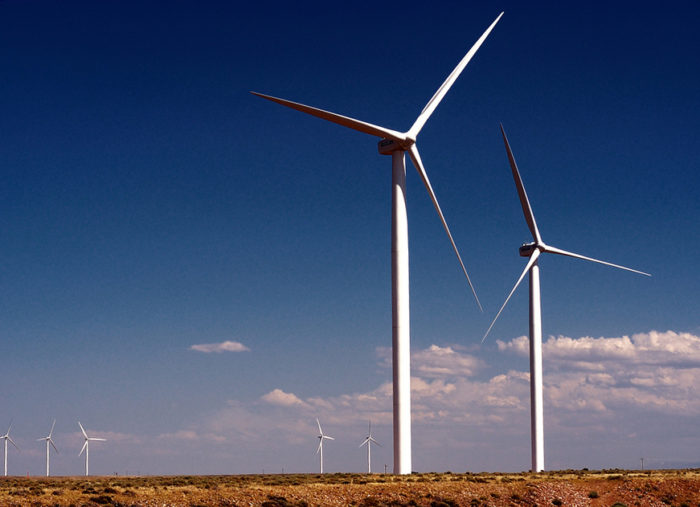
Image Credit: a4gpa / Flickr
A finance package extending tax credits for wind power to the end of next year, recently approved by a key U.S. Senate panel, has been hailed as progress for clean energy, and it is. But here at Environment America, we’re containing our enthusiasm.
According to the finance deal adopted in committee, the Production Tax Credit for onshore wind and the Wind Investment Tax Credit for offshore wind will be reinstated retroactively to the start of 2015 and expire in 2016. The bill doesn’t address the Renewable Energy Investment Tax Credit, which primarily benefits solar energy and is currently in effect; it will expire at the end of 2016.
The bottom line: even if these tax credit extensions quickly become the law of the land, solar and wind power will still be on a mighty short leash. Incentives for both pollution-free resources will dry up in 18 short months, while billions of dollars of fossil fuel subsidies remain embedded in our tax code.
Why do wind and solar power need long-term tax incentives?
Incentives will help solve the climate crisis
First and foremost, we need these energy sources to solve the climate crisis. Scientists are clear that we must make drastic cuts in pollution and get off fossil fuels to avoid the temperature increases that will wreak havoc on our climate.
Our research shows that by 2030 we could quite easily get 10% of our power from the sun and 30% from the wind. Researchers at Stanford University have published a series of studies showing the path to 100% clean energy, and wind and solar are central.
Dirty energy is artificially cheaper
In most electricity markets in America, dirty energy sources are still artificially cheaper than the clean ones. That’s in part because state and federal governments give away roughly $20 billion every year in cash subsidies and tax breaks to oil, coal, and gas companies; they’ve done it for more than a century.
It’s in part because cheap dirty energy doesn’t reflect its true cost. The health costs associated with air pollution and the costs of extreme weather events associated with climate change are born by society as a whole, and by our children and grandchildren.
Renewables are virtually free in the long term
While wind and solar power have high — but declining — upfront costs, they are virtually free in the long term. The cost of these clean energy sources is almost entirely the upfront capital expense of building and installing turbines and panels to access free sun and wind.
While these prices are falling sharply — solar dropped 35% from 2010 to 2013 — renewable energy investors still must make a sizable down payment before society reaps the benefits of low-cost clean power. That’s especially true of offshore wind, which holds enormous promise but hasn’t yet seen the price declines that come with widespread deployment.
Investors need long-term stability
Lenders and investors need long-term certainty. Eighteen months is certainly better than nothing, but it won’t really do for a lender making loans to energy investors over 10 years or more. In the same way that steady employment qualifies you for a lower interest rate on your home mortgage, the certainty of tax credits for the long term qualifies energy investors for lower interest rates, bringing down their capital costs.
Eighteen months is a start, and we’re encouraged by the bipartisan support in the Senate for moving forward. But ultimately, Congress should approve long-term clean energy incentives to ensure the sustained growth in solar and wind power that the American people deserve, and that the climate crisis demands.
Rob Sargent is the energy program director for Environment America. This post originally appeared at The Huffington Post.
Weekly Newsletter
Get building science and energy efficiency advice, plus special offers, in your inbox.















2 Comments
Green
I recently have been writing a research paper on green buildings and the effects that having more green buildings could have on our environment and economy. Many times up-front costs for high efficiency buildings are large, but where they shine is in annual costs. Payback really ranges depending on the size of the building and the magnitude of renovations/features. Solar panels and wind turbines have longer payback periods ranging from 10 to 15 years (Acitelli). I have also done a lot of research on the LEED program, and what specific requirements they have to become certified. There are obvious environmental and economic benefits to getting your building LEED certified, however as of 2012 only 41% of nonresidential buildings where built green (Green Building Facts). To help further reduce CO2 emissions, lower water use, and help the environment in general I believe that buildings need to meet minimum standards for energy and water consumption.
Acitelli, Tom. "How Soon Can You See Green From Building Green?" Observer. 20 Apr. 2010. Web. 2 Dec. 2015. .
"Green Building Facts | U.S. Green Building Council." Green Building Facts | U.S. Green Building Council. 23 Feb. 2015. Web. 2 Dec. 2015. .
Response to Zach R
Zach,
You wrote, "Solar panels and wind turbines have longer payback periods ranging from 10 to 15 years."
Longer than what? Certainly not longer than many energy retrofit measures or energy-efficiency upgrades promoted by some people who haven't done the math recently. For more on this topic, see Deep Energy Retrofits Are Often Misguided.
Log in or create an account to post a comment.
Sign up Log in